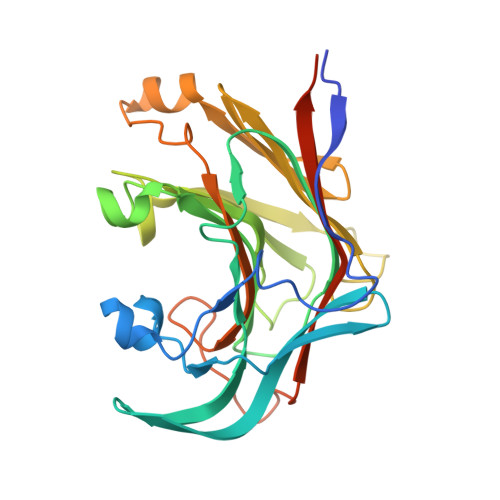Crystal structures of the laminarinase catalytic domain from Thermotoga maritima MSB8 in complex with inhibitors: essential residues for beta-1,3 and beta-1,4 glucan selection.
Jeng, W.Y., Wang, N.C., Lin, C.T., Shyur, L.F., Wang, A.H.(2011) J Biol Chem 286: 45030-45040
- PubMed: 22065588
- DOI: https://doi.org/10.1074/jbc.M111.271213
- Primary Citation of Related Structures:
3AZX, 3AZY, 3AZZ, 3B00, 3B01 - PubMed Abstract:
Laminarinases hydrolyzing the β-1,3-linkage of glucans play essential roles in microbial saccharide degradation. Here we report the crystal structures at 1.65-1.82 Å resolution of the catalytic domain of laminarinase from the thermophile Thermotoga maritima with various space groups in the ligand-free form or in the presence of inhibitors gluconolactone and cetyltrimethylammonium. Ligands were bound at the cleft of the active site near an enclosure formed by Trp-232 and a flexible GASIG loop. A closed configuration at the active site cleft was observed in some molecules. The loop flexibility in the enzyme may contribute to the regulation of endo- or exo-activity of the enzyme and a preference to release laminaritrioses in long chain carbohydrate hydrolysis. Glu-137 and Glu-132 are proposed to serve as the proton donor and nucleophile, respectively, in the retaining catalysis of hydrolyzation. Calcium ions in the crystallization media are found to accelerate crystal growth. Comparison of laminarinase and endoglucanase structures revealed the subtle difference of key residues in the active site for the selection of β-1,3-glucan and β-1,4-glucan substrates, respectively. Arg-85 may be pivotal to β-1,3-glucan substrate selection. The similarity of the structures between the laminarinase catalytic domain and its carbohydrate-binding modules may have evolutionary relevance because of the similarities in their folds.
Organizational Affiliation:
Institute of Biological Chemistry, Core Facility for Protein Production and X-ray Structural Analysis, Academia Sinica, Taipei 115, Taiwan.















